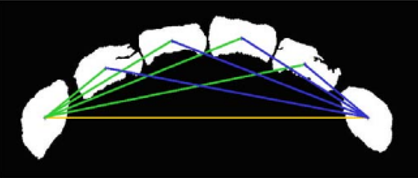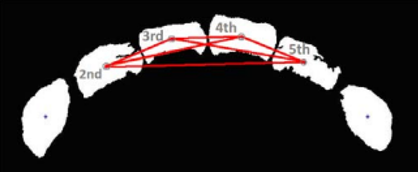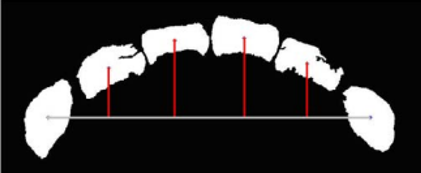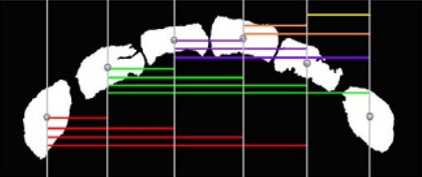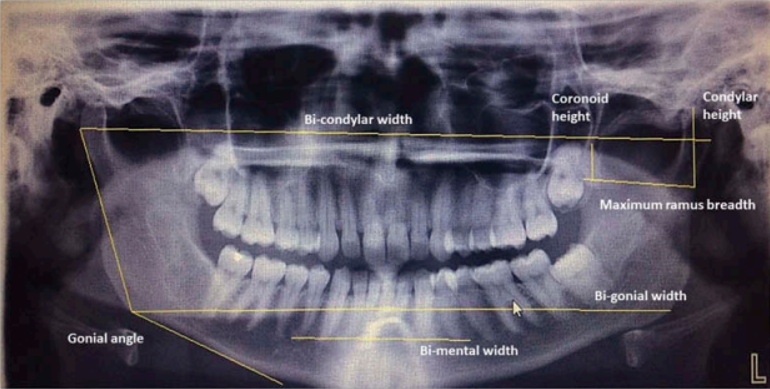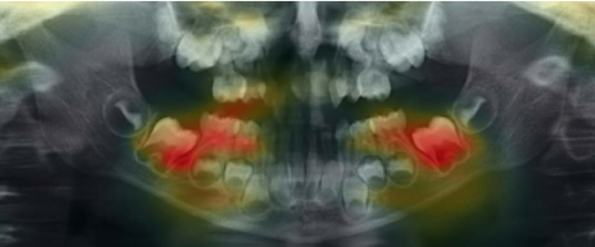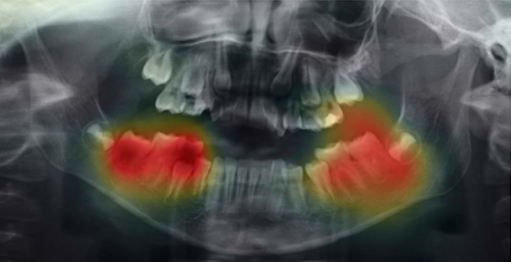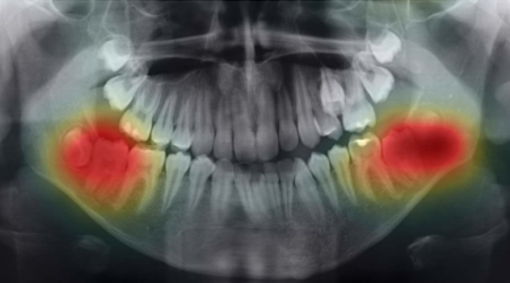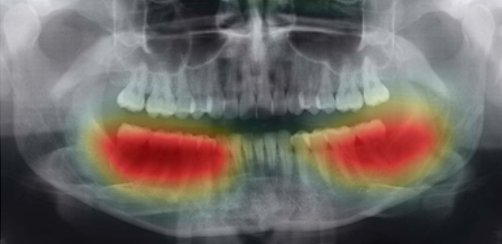Introduction
Robotic preferment which replicates the human brain has revolutionized dentistry. Forensic odontology or forensic dentistry as defined by Federation Dentaire Internationale (FDI) is a branch of dentistry which, in the interest of justice, deals with the proper handling and examination of dental evidence and with the proper evaluation and presentation of dental findings.1 Forensic odontology is emerging naturally along with the advances in technological and medical science. For a long time now dental and medical documentation has been computerized and kept in cloud servers as backups, these records were successfully used for the identification of mass disaster victims of the World Trade Centre disaster,2 Indian Ocean tsunami disaster,3 etc. In most of the disaster cases, the corpses are severely dismembered beyond identification, with remains of teeth and skull jaw bone which possess an extraordinary resistance to extreme conditions. The size and overall structure of the jawbone play a crucial role in serving as substantial evidence when estimating the gender of the victim. In fact, through meticulous analysis of the skeletal composition, particularly focusing on the skull bones, the accuracy of gender determination can reach an impressive 90%.4 This becomes especially valuable in the context of major disasters, where visual identification is rendered impossible due to extensive mutilation of the body. Thus, the remains of the skull, jawbones, and teeth emerge as the most invaluable sources for establishing the identity of the individual.5
It is noteworthy that the shape of the mandible, or lower jawbone, is predominantly determined by the forces exerted during the act of chewing, which typically exhibit variations between males and females. Leveraging radiographic techniques for gender estimation, employing X-ray imaging specifically of the jawbones, presents itself as a more viable approach. This method boasts several advantages as it is relatively simple, non-destructive, and can be applied to both deceased and living subjects. Its practicality and effectiveness make it an appealing choice for forensic analysis and identification purposes.6
They have proved to embark on a pivotal aspect in disaster victim identification.7 Numerous techniques have also been used to recognize offenders and victims including the analysis of soft tissue, evaluation of the palatal rugae pattern, and analysis of the lip pattern, all of which are thought to be personalized.8 The advancement in technologies that are replicas of the human brain have been applied in forensic odontology. These technologies use algorithms termed artificial intelligence (AI) models.9 These AI models are then trained to be used in Problem-solving and decision-making processes which reduce manual work by saving human hours which aids multitasking abilities. Similarly, these AI models can be used in Forensic Odontology identifications. 10 These significant progresses made with the help of AI technology have proved to provide a clear leap in offering accurate data for decision-making. According to studies, artificial intelligence technology may be used to determine a person's age and gender from their dental remains. 11, 12 Hence this review aims at identifying the development of AI applications that are used in Forensic Odontology and evaluating their performance.
Objectives
The objective of this review is to identify and examine the development and application of AI technologies in forensic odontology. By evaluating the performance of these AI applications, this review aims to assess their effectiveness in enhancing the field of forensic odontology and contributing to accurate data-driven decision-making.
Materials and Methods
The present literature review was conducted by searching the literature online on Google Scholar, PubMed, Medline, and IEEE Xplore databases, up to December 2022. A combination of search terms was constructed from "forensic", "forensic odontology", "artificial intelligence," "machine learning," "deep learning," "convolution neural network," "automated," "computer-assisted diagnosis," "diagnostic imaging" and "dentistry."
Following the inclusion criteria outlined; 1.) Articles available in full text. 2.) Articles in the English language only. 3.) Translated articles were excluded from the study. 4.) Those articles that were focused on the bite mark analysis (2), AI in gender determination (6), and AI in Age estimation (6) were selected. After applying the inclusion criteria in the end only 14 articles were left. All these 14 articles were thoroughly read and analyzed by all the authors and the review was summarized.
Discussion
The use of forensic odontology is appreciated in the identification of victims of mass destruction, in which the identification of the remains is near to impossible, with visual ways reporting high levels of error. 13 Dental remains can help in the identification of victims via matching their dental records, 14 which most of the time help in age estimation 15 and sex determination. 16 The gender and age of any person play a pivotal role in recognizing victims of mass destruction, human assaults, etc.
Artificial Intelligence is being used in forensic sciences quite often. It is very accurate in estimating the age and the sex of the living and the deceased 17 which could be credited to computerized algorithms that make minimal blunders when recognizing irrational patterns.
Use of AI in Bite mark identification
Bite marks are widely viewed as integral proof during sexual assaults, homicide after rape, rape, sexual abuse, and child abuse. As the human body starts wound healing, the bite marks start to fade away making it difficult for a Forensic Odontologist to analyze it and identify the perpetrator. A study reported by Mahasantipiya et al 18 reported on the use of AI for bite mark analysis which was designed to identify bite marks in various forensic cases. They transformed the bite mark sample from a bit depth of 32 to an 8-bit grayscale (0-255), where 0 represented the darkest and 255 represented the brightest. Later, the contrast of each image was adjusted using Contrast Limited Adaptive Histogram Equalization. The region of interest, covering only the anterior teeth, was cropped. Next, the median filter was applied to enhance the borders of each tooth bite mark, and then the image was converted to a black-and-white format. In this study, researchers identified seven groups (Figure 1, Figure 2, Figure 3, Figure 4) 18 of features that were used as input data for artificial neural network (ANN) modeling. These features were carefully chosen to capture various aspects of the teeth, such as their positions, angles, and shapes. By including these features in the ANN model, the researchers aimed to uncover patterns and relationships within the data. The first group of features, known as CC, represented the distance between the centric point of the left canine and the right canine. Each sample provided one data point for this feature. The second and third groups of features, I-LC Angle and I-RC Angle, involved measuring the angles between straight lines connecting the centric point of each anterior tooth to the centric point of the left and right canines, respectively. Each sample contributed four data points for these features. The fourth group of features focused on angles between horizontal lines and lines connecting different centric points. Specifically, the angles were measured between:
Table 1
Figures from study by Mahasantipiya et al 18
For each sample, six data points were obtained from this group of features. The fifth group of features focused on the curvature of the parabola that best fit the set of centric points of the anterior teeth. This feature was called Coefficient A. The sixth group of features, known as iRatio, involved calculating the ratio of distances for each incisor tooth. Specifically, the shortest distance between I-CC and I-CC was measured. Each sample contributed four data points for this feature. Lastly, the seventh group of features, HTT-D, measured the distance between two tooth-centric points projected on the CC line. Notably, this group excluded the distance between the centric point of the left canine and the right canine, which was already captured in the CC feature. By considering these seven groups of features, the researchers aimed to leverage the power of the ANN model to analyze and understand the relationships between these measurements and potentially predict outcomes or patterns related to the teeth.
Figures from study by Mahasantipiya et al 18
They used ANN (artificial neural network) in bite mark analysis and the results of the study were quite promising. The results showed high accuracy, and the authors stated that the computer-aided analysis only aims to minimize human bias. Also, the authors reported that the results of this study may not be used as a tool to identify crime, which warrants further research and development of this model.
Use of AI in gender identification
Determining a person's gender is crucial for mass catastrophe identification, accidental remains, and medico-legal issues. Jaw bone and teeth are immune to wear even under extreme conditions and hence play a vital role in post-mortem identification. 19 The teeth which are least affected by dental caries are the canine teeth, hence it is retained in the jaw for the longest period after death, it also shows higher degrees of sexual dimorphism and hence can be used in gender determination of the living or the dead. 20 A study conducted by Patil et al 21 employs Artificial Neural Networks (ANN) for gender determination and compares the obtained results with logistic regression and discriminant analysis using mandibular parameters (Figure 5) as inputs. The researchers utilize digital panoramic radiographs to measure the mandible of 509 individuals. The main objective of this research is to evaluate the effectiveness of ANN in gender determination and to compare its performance with traditional statistical methods (logistic regression and discriminant analysis). The researchers analyzed two commonly used gender determination methods, namely discriminant analysis and logistic regression, along with artificial neural networks (ANN). Discriminant analysis is a well-established technique known for its reliability in sex discrimination and has been previously employed by researchers in similar studies. When applied in this study, discriminant analysis achieved an accuracy rate of 69.1% in correctly identifying males and females. The results showed that 79% of females and 66.9% of males were accurately classified using all six morphometric parameters considered in the analysis (Figure 5). 21
However, it is worth noting that the accuracy level for males was relatively lower, which is consistent with findings from previous studies. 22, 23 Furthermore, logistic regression, another statistical method used in this study, exhibited an overall accuracy rate of 69.9%. In terms of gender classification, logistic regression correctly identified 67.4% of females and 72.2% of males. These findings indicate that logistic regression performed slightly better in accurately categorizing males compared to females. Overall, this study provides comparative insights into the performance of discriminant analysis, logistic regression, and artificial neural networks in gender determination. The results suggest that both discriminant analysis and logistic regression can be effective methods, but they may have varying levels of accuracy when applied to different gender groups. In simpler words, when comparing artificial neural networks to previously employed methods like discriminant analysis and logistic regression, their study found that artificial neural networks are more accurate at predicting gender. Because it automates and simplifies the process of recognizing an unknown person with few mistakes, the implementation of this technology in the field of forensic sciences is therefore potential. 21
Use of AI in age estimation
Age estimation plays an important role in individual identification and medico-legal cases where age plays an important role as a judgment in the criminal justice system is based on age. 24 the age of the individual is usually achieved by hand wrist radiograph and nowadays by feeding the OPG data to an AI. 25 A study done by Blanco 26 et al on 2289 OPG images while comparing 2 fully automatic AI namely DANet and DASNet were used to estimate age and reported that the results were as accurate as a manual estimation. The first DANet uses a one-way path where convolution and pooling layers are coupled and it learns distinctive features at various shapes and sizes and, subsequently, estimates age. To estimate sex, the second technique, DASNet, adds a second, basically identical channel. To make the age path incorporate sex-specific traits at key places, the sex path shares data with it. In this manner, sex information is considered to enhance the age estimation procedure. In their study, the authors observed a strong correlation between the ages estimated by two deep learning models, DANet and DASNet, and the actual ages of the subjects. The R-squared values for the correlation were 0.87 and 0.90, respectively, indicating a high degree of accuracy in age estimation. When comparing the performance of the two models using the Sall dataset, DASNet demonstrated superior results. The mean absolute error (AE) for DASNet was approximately 2 years and 10 months, with a median error (E) of +0.12 years. The AE values consistently decreased as the real ages of the subjects decreased in both networks, but DASNet consistently outperformed DANet in all cases, particularly in the DASNet dataset. In the S<15 datasets, the mean AE was 0.78 years for DANet and 0.75 years for DASNet, with median AE values of 0.64 years for both networks. The standard deviation, interquartile range (IQR), and p99 values of AE also decreased systematically as the real age decreased, indicating improved accuracy. DASNet achieved lower values in all these measures compared to DANet, with standard deviations of 0.57 and 0.65, IQRs of 0.72 and 0.81, and p99 values of 2.58 and 2.91, respectively.
Considering the superior performance of DASNet, further analyses focused on this model. The correlation between the predicted ages by DASNet and the real ages was notably higher for subjects younger than 20. In the reduced datasets used for comparison with classical methods, the automatic approach exhibited better performance for subjects younger than 14 or 15, but its accuracy gradually declined with older subjects. This limitation was evident in the final plot, where the network seemed to lack sufficient information to accurately estimate the age of older subjects. The paper introduced two deep-learning approaches for age estimation from an OPG image. The first approach, DANet, employed a single path with interleaved convolution and pooling layers to learn image features at different scales and estimate age. The second approach, DASNet, added a second path, nearly identical to the first, to estimate sex. By sharing information between the sex and age paths, DASNet incorporated sex-specific features to improve the age estimation process, the OPGs were colored red whereas the AI models focused more (Figure 6, Figure 7, Figure 8, Figure 9).26 Across all tested scenarios, DASNet consistently outperformed DANet. Notably, when trained with the S<15 datasets, DASNet achieved remarkable results with mean and median AE values of 0.75 and 0.64 years, respectively, and a standard deviation below 0.6 years. This narrow error distribution indicated high precision. However, as expected, the performance of both models declined when older individuals were included in the experiment, as age estimation becomes more challenging for those over 25 when permanent teeth are fully formed. Despite these challenges, the fully automatic method outperformed manual age estimation methods in most cases, even when working with images that had technical issues. The behavior of DASNet aligned with clinical age estimation methods that rely on the posterior mandibular teeth, thus demonstrating clinical consistency in its predictions. The AI models gave a picture where the model focused in red.
While adding to the study the authors also agreed upon the fact that DASNet was a better AI than DANet in all the aspects measured. The results were quite similar to those given by Halabi27 et al who used CNN (Convolution Neural Network) to estimate the age using AI employed to check hand wrist radiograph, where the algorithms analyzed the age to near human perfection showing promising future for application in age estimation for various reasons. Similar studies by Kim S et al 28 and De Tobel J et al 29 showed promising results in integrating AI in estimating age using other parameters.
Future Scope
Innovative proposals such as the collection of bite marks before every flight have the potential to revolutionize the field of Forensic Odontology. By creating a comprehensive government database of bite marks, AI systems can be trained on a vast amount of data, enabling them to accurately and efficiently match bite marks to potential suspects. This proactive approach can significantly enhance the investigative process, leading to increased accuracy and speed in identifying perpetrators. However, it is important to address ethical considerations, such as ensuring consent, privacy protection, and the responsible use of AI technology in forensic investigations. Collaborative efforts between forensic experts, legal professionals, and AI specialists are essential to establish guidelines and frameworks that govern the appropriate use of AI in Forensic Odontology. From the present review, it is beyond doubt that AI technology is being used in Forensic Odontology in many instances. Further studies should be done on the use of AI in real-life scenarios in medico-legal cases, disaster victim identification, parental disputes, etc. Furthermore, the authors of this review suggest that bite marks be taken before every flight to gather a government database which would further help in training the AI.
Limitations of the Review
Incomplete coverage
There is a possibility that some relevant studies may have been missed or not included in the review due to limitations in search strategies, access to databases, or language restrictions. This can result in an incomplete representation of the existing knowledge on the topic.
Time-dependent relevance
The literature is continuously evolving, with new studies and findings being published regularly. A literature review represents a snapshot of the existing literature up until a certain point in time. Consequently, new research conducted after the review may yield additional information or contradict the findings of the review.
Lack of primary data
A literature review relies on the synthesis of existing published studies and does not involve the collection of primary data. The review is dependent on the quality, accuracy, and completeness of the data reported in the included studies. Limitations or errors in the primary studies can impact the validity and reliability of the findings in the literature review.
Conclusions
As digitalization is on the verge, AI has been pivotal in changing the mode of forensic analysis from manual to computerized methods. Artificial Intelligence (AI) has the potential to transform vast amounts of data into information, enabling its analysis and interpretation. This reduces human labor and hours while providing the convenience of cloud accessibility. Some researchers consider AI as equivalent to the human brain, as it mimics human intelligence. The integration of AI technology in Forensic Odontology has shown remarkable potential, as evidenced by the findings of the present review. The application of AI algorithms and machine learning techniques has proven invaluable in various aspects of forensic analysis, including dental identification, bite mark analysis, and dental age estimation. Further studies and research in real-life scenarios are crucial to fully realize the benefits of AI in Forensic Odontology. Medico-legal cases present complex challenges where AI can assist in analyzing dental records, comparing them to the remains or evidence, and providing accurate identification. By leveraging AI's capabilities, forensic odontologists can expedite the identification process and contribute to more efficient and reliable legal investigations. Although further research is required to explore the maximum potential of AI, current studies show promising results.
In conclusion, the present review highlights the immense potential of AI in Forensic Odontology. Further research and practical implementation of AI in real-life scenarios can revolutionize the field, enabling faster and more accurate dental identification, bite mark analysis, and age estimation. By embracing AI technology and its capabilities, forensic odontologists can enhance their investigative abilities, ultimately contributing to more effective and efficient forensic practices.

